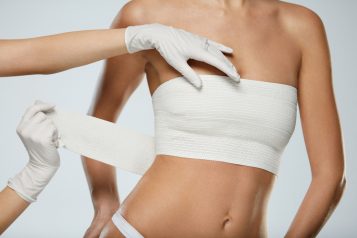Nationally renowned board-certified plastic surgeon, Dr. Jose Rodríguez-Feliz serves local and international clients at his boutique aesthetic practice in Miami, FL. Dr. Rodríguez-Feliz is one of few surgeons in the United States that after completing his Residency in Plastic and Reconstructive Surgery, pursued further training in Oculoplastic and Aesthetic Surgery under world-renowned plastic surgeon Dr. Mark Codner. This gave him the opportunity of nurturing his passion for form and beauty as well as to earn a specialization in aesthetic eyelid surgery (blepharoplasty), complex/revision eyelid surgery, correction of droopy eyelids (ptosis surgery), facial plastic surgery (e.g. face/neck lifts, nose surgery, ear surgery), non-surgical facial rejuvenation (e.g. Botox/Dysport, dermal fillers), and aesthetic breast surgery (e.g. endoscopic breast augmentation).
 Photo Credit: Shutterstock
Photo Credit: Shutterstock
Although the chin may comprise just a small part of the face, it plays a pivotal role in the overall facial balance that conveys an attractive appearance. Oftentimes, enhancing the contours and projection of the chin can help bring all of a patient’s facial features into harmony, and there are several chin augmentation approaches, including non-invasive and surgical options.
According to Haute Beauty expert and Miami, Florida plastic surgeon Dr. Jose Rodríguez-Feliz, the ideal chin augmentation approach is often based on the precise measurement of the angles and symmetry of each patient’s facial features. He uses the VECTRA 3D Facial Analysis imaging tool to “map” the contours of the face, illustrate the ideal chin correction that can optimize the overall appearance of the face, and give patients an idea of what post-procedural outcomes could look like.
The projection of the chin is especially significant, and a jaw that falls behind the lower lip can cause the face to appear unbalanced. Often referred to as a “weak chin,” this condition can be intensified by a disproportionately large nose (which is why many rhinoplasties and chin augmentation are often performed in tandem). There are both non-surgical and surgical ways to enhance chin projection, and the ideal approach is often dictated by the level of correction necessary.
Injectable fillers
For patients in need of a minor increase in chin projection and enhancement of jawline definition, injectable fillers can provide subtle improvement. Dr. Rodríguez-Feliz usually recommends a firmer hyaluronic acid-based filler such as Voluma or Restylane Lyft, or a longer-lasting filler such as Radiesse for the chin. Injectable fillers can also provide a way to test-drive minor chin enhancement results, which can last for up to 24 months (although periodic touch-ups may be necessary).
 Photo Credit: Shutterstock
Photo Credit: Shutterstock
Fat grafting
A patient’s own fat can be used for chin augmentation as well. Often used in place of hyaluronic acid and other injectable fillers, fat represents a safe, longer-lasting and natural-looking alternative with no risk of allergic reaction. Fat grafting begins with harvesting fat from another area of the body (usually the thighs, buttocks or abdomen) via a gentle liposuction-like procedure under local anesthesia. The fat is prepared before it is injected into the chin little by little until the desired result is achieved. Fat grafting comes along with about a week of minor swelling and bruising at the donor and treatment sites, and results can last for up to five to seven years (or more).
Chin implants
Chin implants are generally made of silicone and they come in various shapes and sizes to create the ideal degree of projection or definition enhancement for each patient. Although implants can be used for subtle augmentation, this procedure is especially well-suited for patients whose “weak chin” or asymmetry requires substantial augmentation to restore facial harmony—and results are permanent.
When performing chin augmentation with an implant, Dr. Rodríguez-Feliz hides the incisions under the chin so they are nearly invisible once healed. (Incisions can be placed within the mouth as well, but most plastic surgeons prefer an external approach to minimize the risk of infection due to bacteria in the mouth.) The procedure itself is relatively quick, but patients can expect swelling and bruising for up to a week and restricted activity for up to four to six weeks to prevent implants from shifting before adequately healing has taken place.
Chin augmentation requires a surgeon with an artistic vision who takes a variety of other factors into consideration when planning non-invasive or surgical intervention, as the ultimate appearance of the chin is intrinsically tied to the cheeks, nose, lips and forehead as well. The goal of any chin augmentation procedure is to create balance and harmony across the entire face as well as the neck, which is why liposuction beneath the chin or on the neck may be recommended as well to obtain optimal results.
For more information, visit Dr. Brian A. Levine's social media:

























